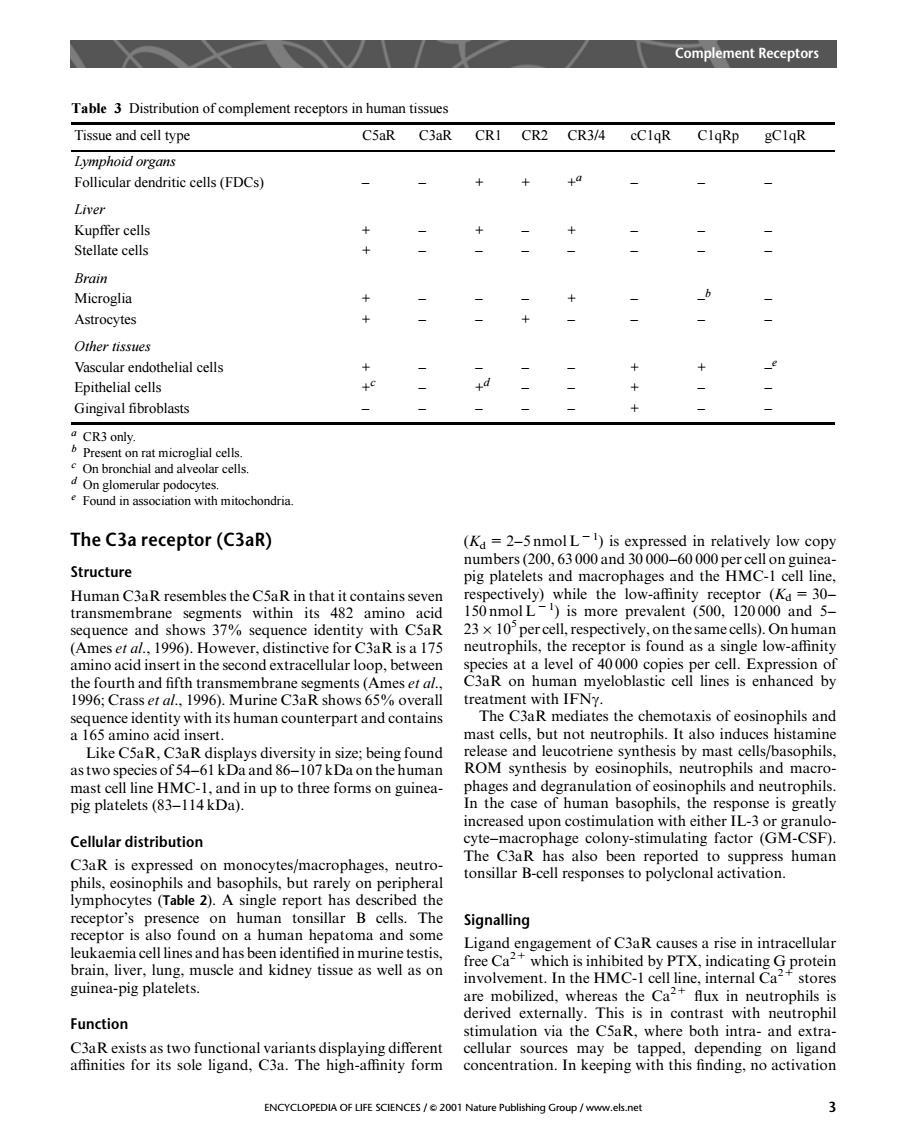正在加载图片...

Complement Receptors Table 3 Distribution of complement receptors in human tissues Tissue and cell type C5aR C3aR CRI CR2 CR3/4 cClqR ClqRp gClqR Liver Stellate cell croglia Astrocytes Other tissues Vascular endothelial cells Epithelial cells Gingival fibroblasts The C3a receptor(C3aR) 2-5nmolL-1 is 200.63000 relatively low cop e. Structure pig platelets and macrophages and the HMCI celline Human c3ar resembles the c5ar in that it contains sever transmembrane segments within its 482 amino 20000and5 sequence and sho 37%sequence identity (Ames erdins weve in the 5a175 esat a level of 0000 copie er cell Exn ession of the fourth and fifth transmembrane se nts (Ames etal aoman myeloblastic cll lines is enhanced by 1996:Crass et al..1996).Murine C3aR shows 65%overall with its human counterpart and contains and Like CSaR.C3aR d onhils as two spe ecies of 54-61 kDaand 86-107kDaon the human ROM synthesis by eosinophils,neutrophils and macro mast cell line HMC-1,and in up to three forms on guinea- sinophils and neutrophil pig platelets(83-114 kDa). gre Cellular distribution evte-macrophage colony-stimulating factor(GM-CSF). C3aR is expressed on monocytes/macrophages,neutro The C3aR has also been reported to suppress human tonsillar B-cell responses to polyclonal activation. phils,eosinoph ymp ytes (T abland basophi T receptor is also found on a human hepatoma and some Signalling Ligand engagement of C3aR causes a rise in intracellular 比and dney时西e。 free Ca 2 Function stimulation via the C5aR,where both intra-and extra 2a0 y ENCYCLOPEDIA OF LIFE SCIENCES/2001 Nature Publishing Group /www.els.net The C3a receptor (C3aR) Structure Human C3aR resembles the C5aR in that it contains seven transmembrane segments within its 482 amino acid sequence and shows 37% sequence identity with C5aR (Ames et al., 1996). However, distinctive for C3aR is a 175 amino acid insert in the second extracellular loop, between the fourth and fifth transmembrane segments (Ames et al., 1996; Crass et al., 1996). Murine C3aR shows 65% overall sequence identity with its human counterpart and contains a 165 amino acid insert. Like C5aR, C3aR displays diversity in size; being found as two species of 54–61 kDa and 86–107 kDa on the human mast cell line HMC-1, and in up to three forms on guineapig platelets (83–114 kDa). Cellular distribution C3aR is expressed on monocytes/macrophages, neutrophils, eosinophils and basophils, but rarely on peripheral lymphocytes (Table 2). A single report has described the receptor’s presence on human tonsillar B cells. The receptor is also found on a human hepatoma and some leukaemia cell lines and has been identified in murine testis, brain, liver, lung, muscle and kidney tissue as well as on guinea-pig platelets. Function C3aR exists as two functional variants displaying different affinities for its sole ligand, C3a. The high-affinity form (Kd= 2–5 nmol L 2 1 ) is expressed in relatively low copy numbers (200, 63 000 and 30 000–60 000 per cell on guineapig platelets and macrophages and the HMC-1 cell line, respectively) while the low-affinity receptor (Kd= 30– 150 nmol L 2 1 ) is more prevalent (500, 120 000 and 5– 23 105 per cell, respectively, on the same cells). On human neutrophils, the receptor is found as a single low-affinity species at a level of 40 000 copies per cell. Expression of C3aR on human myeloblastic cell lines is enhanced by treatment with IFNg. The C3aR mediates the chemotaxis of eosinophils and mast cells, but not neutrophils. It also induces histamine release and leucotriene synthesis by mast cells/basophils, ROM synthesis by eosinophils, neutrophils and macrophages and degranulation of eosinophils and neutrophils. In the case of human basophils, the response is greatly increased upon costimulation with either IL-3 or granulocyte–macrophage colony-stimulating factor (GM-CSF). The C3aR has also been reported to suppress human tonsillar B-cell responses to polyclonal activation. Signalling Ligand engagement of C3aR causes a rise in intracellular free Ca2+ which is inhibited by PTX, indicating G protein involvement. In the HMC-1 cell line, internal Ca2+ stores are mobilized, whereas the Ca2+ flux in neutrophils is derived externally. This is in contrast with neutrophil stimulation via the C5aR, where both intra- and extracellular sources may be tapped, depending on ligand concentration. In keeping with this finding, no activation Table 3 Distribution of complement receptors in human tissues a CR3 only. b Present on rat microglial cells. c On bronchial and alveolar cells. d On glomerular podocytes. e Found in association with mitochondria. Tissue and cell type C5aR C3aR CR1 CR2 CR3/4 cC1qR C1qRp gC1qR Lymphoid organs Follicular dendritic cells (FDCs) – – +++a ––– Liver Kupffer cells + – + – + ––– Stellate cells + – ––– – – – Brain Microglia + – –– + – –b – Astrocytes + – – + –– – – Other tissues Vascular endothelial cells + – ––– + + –e Epithelial cells +c – +d – – + – – Gingival fibroblasts – – ––– + – – Complement Receptors ENCYCLOPEDIA OF LIFE SCIENCES / & 2001 Nature Publishing Group / www.els.net 3�